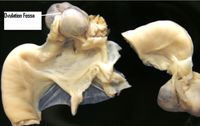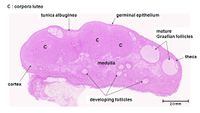Difference between revisions of "Ovary - Anatomy & Physiology"
Thepollycat (talk | contribs) |
|||
| Line 111: | Line 111: | ||
{{Template:Learning | {{Template:Learning | ||
|powerpoints = [[Female Reproductive Tract Histology resource|Histology of the female reproductive tract]] | |powerpoints = [[Female Reproductive Tract Histology resource|Histology of the female reproductive tract]] | ||
| − | |videos = [[Video:Porcine uterus potcast|Potcast of the porcine ovaries and uterus]]<br>[[Video: Bovine Pregnant Uterus|Potcast of the bovine pregnant uterus]]<br>[[Video: Mare ovary and uterus dissection|Mare ovary and uterus dissection]]<br>[[Video: Bisected ovary from the mare potcast|Bisected ovary from the mare potcast]] | + | |videos = [[Video: Porcine uterus potcast|Potcast of the porcine ovaries and uterus]]<br>[[Video: Bovine Pregnant Uterus|Potcast of the bovine pregnant uterus]]<br>[[Video: Mare ovary and uterus dissection|Mare ovary and uterus dissection]]<br>[[Video: Bisected ovary from the mare potcast|Bisected ovary from the mare potcast]] |
}} | }} | ||
Revision as of 16:53, 13 November 2012
Introduction
The ovary is the female Gonad homologous to the male Testes. It is usually a paired organ in domestic species, but in the bird only the left Ovary is present. The structures found within the ovary are undergoing constant changes throughout the oestrus cycle from the Follicles containing Oocytes, to the formation of Corpus Haemorrhagicum, Corpus Luteum, and finally Corpus Albicans. Ovaries are ellipsoidal in shape with an irregular surface due to the projection of dominant follicles and corpora lutea. These irregularities are absent in the mare due to the cortex and medulla being reversed with ovulation only occuring from the ovulation fossa. They are greatest in Polytocious animals such as the sow due to many dominant follicles, and so corpora lutea, developing at once.
Anatomical Location
- In the dog and cat, ovaries do not migrate in development. They remain in the dorsal part of the abdomen, caudal to the kidneys at the tip of the uterine horns.
- In other domestic species, the ovaries migrate during development.
- The greatest degree of migration occurs in ruminants. Here, the ovaries come to lie close to the ventral abdominal wall, cranial to the pelvic inlet.
- In the pig, they descend to the middle of the abdomen.
- In the mare, they are located ~8-10 cm ventral to the dorsal wall of the abdomen.
- In all domestic species except the horse, ovaries are ellipsoidal in shape and their surface has large follicles and corpora lutea.
- The ovaries of the mare are kidney shaped and the surface is smooth.
- The ovaries are suspended in the abdominal cavity by the Mesovarium of the Broad Ligament.
Structure
Outer Tunica Albuginea
- Connective tissue layer covering the ovarian cortex.
- Overlying this structure is a single layered Germinal epithelium.
Ovarian Cortex
- Contains:
- Follicles in various stages of development
- Corpus Luteum (includes Corpus Haemorrhagicum and Corpus Albicans)
Ovarian Medulla
- The Medulla is made up of dense connective tissue. This is where all of the lymphatics, nerves and vasculature of the Ovary are found.
The Mare
- The structure of the ovary is reversed.
- The cortex is in the centre, follicles develop here.
- This layer is enclosed by a dense, richly vascularised connective tissue layer which is analagous to the medulla of other domestic mammals.
- The cortex reaches the surface of the ovary at the ovulation fossa, a deep indentation at the free margin. This is where mature follicles rupture in ovulation, as opposed to at various points on the surface in other domestic mammals.
- Follicles can be identified by transrectal palpation, but Corpora Lutea cannot. Identification of Corpora Lutea requires ultrasonography.
Histology
Stroma
- The body of the ovary (ovarian stroma) consists of:
- spindle-shaped cells
- fine collagen fibres
- ground substance
- Stromal cells resemble fibroblasts, but some contain lipid droplets.
- Bundles of smooth muscle cells are scattered throughout the stroma.
Cortex
- Follicles containing oocytes in various stages of development.
- Atretic Follicles
- Corpora lutea
- Corpora albicans
- The superficial cortex is more fibrotic than the deep, and is called the tunica albuginea.
- On the surface of the ovary is the germinal epithelium. This is a continuation of the peritoneum.
Medulla
- Highly vascular
- Contains hilus cells, which are similar to the Leydig cells of the testes.
Vasculature
Arterial Supply
- The ovarian artery (a branch of the Aorta) and ovarian branches of the Uterine artery form anastomoses in the mesovarium and the broad ligament.
- From this arterial plexus ~10 coiled Helicine arteries enter the hilus of the ovary.
- Smaller branches form a plexus at the corticomedullary junction, giving rise to straight Cortical arterioles, which radiate into the cortex.
- Here they branch and anastomose to form vascular arcades, which give rise to a rich capillary network around follicles.
Venous Drainage
- Venous drainage follows the course of the arterial system.
- Medullary veins are large and tortuous.
- The Ovarian Artery is closely associated with the Uterine Vein. This is important for the transfer of luteolytic PGF2α from the Uterus to the Ovary.
Lymphatics
- Arise in the perifollicular stroma.
- Drain into larger vessels, which coil around the medullary veins.
Innervation
- Sympathetic fibres of the autonomic nervous system supply blood vessels and terminate on smooth muscle cells in the stroma around follicles.
- May play a role in follicular maturation and ovulation, but the main control is via the endocrine system.
Function
It has two main functions:
- Producing the female gametes oocytes via Gametogenesis.
- Producing the reproductive hormones Oestrogens and Progesterone, an endocrine function.
Processes Taking Place In The Ovary
Oogenesis
Folliculogenesis
Ovulation
Corpus Luteum Formation
Corpus Luteum Regression
| Ovary - Anatomy & Physiology Learning Resources | |
|---|---|
 Selection of relevant videos |
Potcast of the porcine ovaries and uterus Potcast of the bovine pregnant uterus Mare ovary and uterus dissection Bisected ovary from the mare potcast |
 Selection of relevant PowerPoint tutorials |
Histology of the female reproductive tract |
Error in widget FBRecommend: unable to write file /var/www/wikivet.net/extensions/Widgets/compiled_templates/wrt6622a8c78e2c02_74156409 Error in widget google+: unable to write file /var/www/wikivet.net/extensions/Widgets/compiled_templates/wrt6622a8c7927499_08350859 Error in widget TwitterTweet: unable to write file /var/www/wikivet.net/extensions/Widgets/compiled_templates/wrt6622a8c796eb37_49823743
|
| WikiVet® Introduction - Help WikiVet - Report a Problem |

